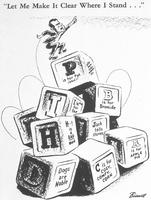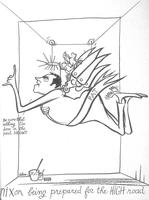1960
| Candidate |
Popular
|
Electoral
|
| John F. Kennedy Democrat |
34,221,344
|
303
|
| Richard M. Nixon Republican |
34,106,671
|
219
|
| John F. Kennedy, by Cecil Stoughton John F. Kennedy Presidential Library & Museum (public domain) |
Although the candidates concentrated on the issues in 1960, the cartoonists focused on the role of the media. The Republicans urged measures for defense against Communism, while the Democrats pushed civil rights at home. Although television had been used extensively before, Republican nominee Richard Nixon and Democratic candidate John Kennedy were the first to meet in debate on nationwide television (44A-1067133). Kennedy got off to a better start, and it was probably his projection of an image of confidence that helped disperse any anxieties over his youth. Nixon was ridiculed for his attempts to "make everything perfectly clear."(44B-1067134, 44C-1067135)
Recalling the 1956 campaign to "clean up Nixon's image," cartoonist Osborn parodies his attempts to cover up his past and his appeal to his dog Checkers in his vindication speech of 1952 (44D-1067136, 44E-1067137). As the election approached, Eisenhower came into the campaign, hoping his popularity would rub off on Nixon, according to cartoonist Bill Mauldin (44F-1067138). Whether anything rubbed off is not certain; Kennedy won a narrow victory.
|
Related Links:
|
|
Charles O. Bissell (1908-2000). From the Association of American Editorial Cartoonists.
Jacob Burck obituary. From the New York Times (May 13, 1982). Jacob Burck. From Spartacus International. Bill Mauldin. Collection of cartoons from Stars and Stripes. Bill Mauldin Beyond Willie and Joe. A tribute from the collections of the Smithsonian. Bill Mauldin Cartoon Collection. From the 45th Infantry Division Museum. Robert C. Osborn (Wikipedia) Robert Osborn obituary. From the New York Times (December 22, 1994). |








